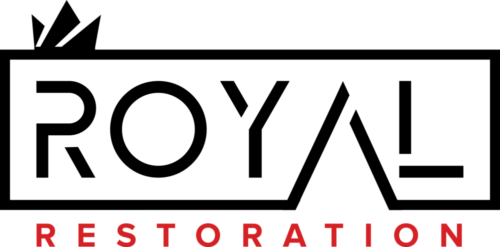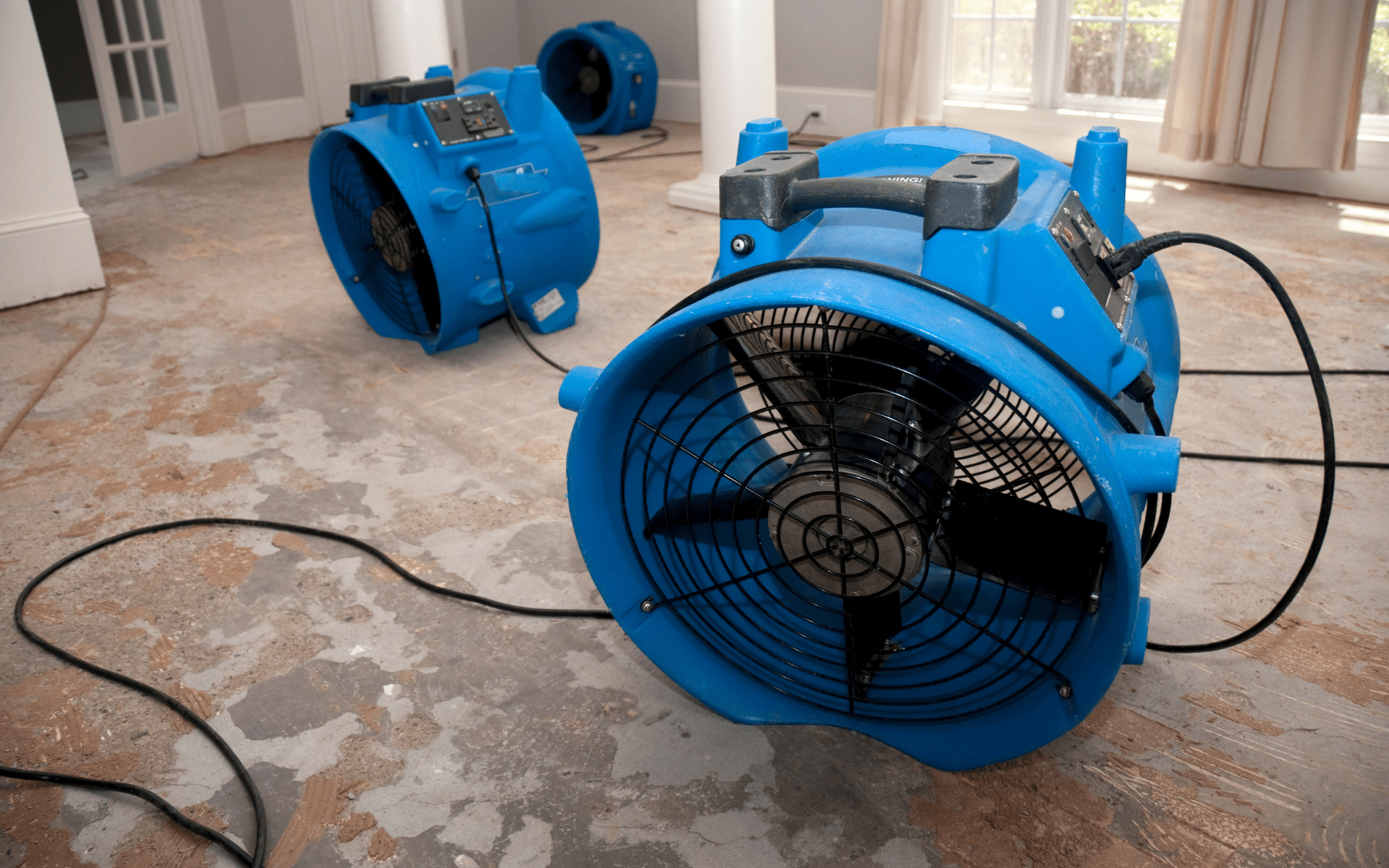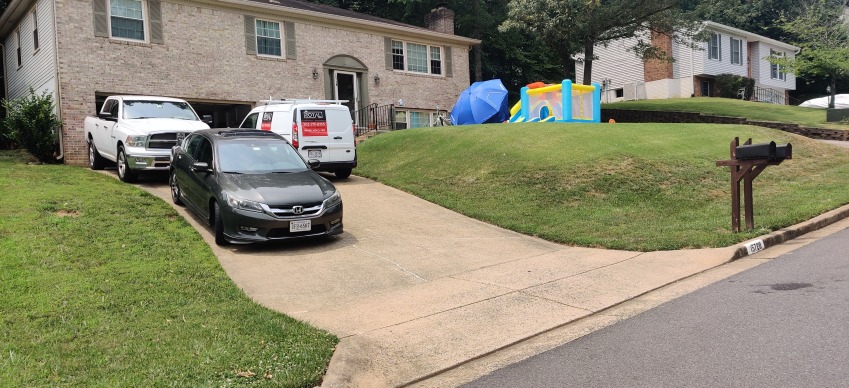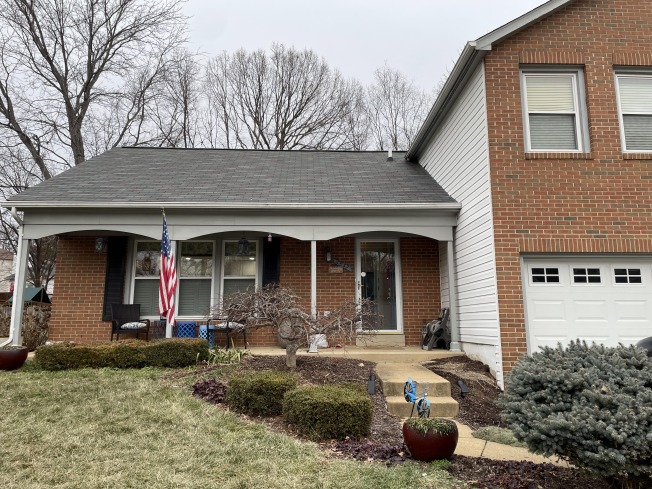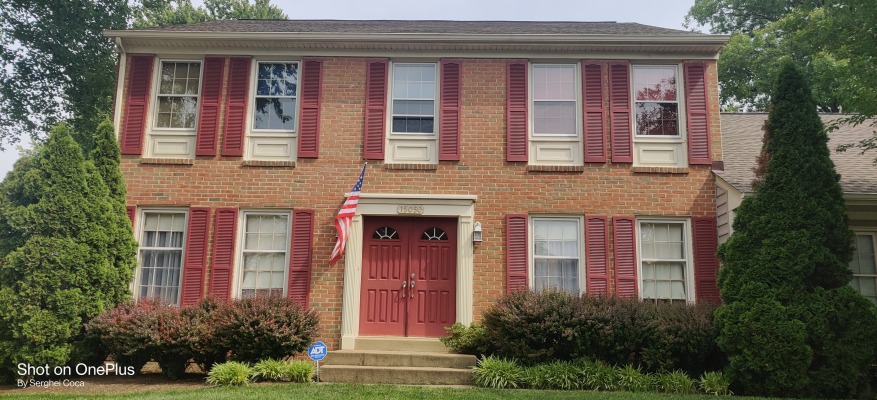Dealing with a flood and water damage in your home can be an extremely stressful and challenging situation. Not only do you have to address the immediate issues like stopping any ongoing water flow and removing excessive standing water, but the water can also lead to structural damage, mold growth, and serious health risks if not properly handled. Do you know how much floor restoration cost is?
When a flood or water leakage occurs in a home, swift action is crucial to minimize restoration costs and prevent further damage. Before you call a restoration company, we have this to guide walk you through everything that influences flood restoration expenses, current pricing from industry data, and exactly what to expect during the flood restoration process.
What Determines Flood Restoration Costs?
According to recent data from Angi, flood restoration cost averages $3,838 nationally, though costs vary dramatically based on the scope and severity of flooding in your home. The Environmental Protection Agency reports that flood damage repairs and renovations typically cost between $20,000 to $40,000 when multiple rooms and systems are impacted. These figures reflect the complex nature of flood restoration, which goes far beyond simply removing standing water. Flood restoration involves emergency water extraction, structural drying that can take days or weeks, damage assessment and documentation, potential mold remediation, structural repairs, and complete restoration of affected materials and systems.
Size of Your Affected Area
The square footage of flooding directly drives your costs because larger areas demand more equipment, materials, and labor hours. The size of the impacted area is often estimated in square footage, which then translates to a total amount of cost to repair. Just a few affected rooms may cost a few thousand dollars while a whole flooded house could cost tens of thousands or more. Location matters too. An isolated basement flooding versus first-floor damage spreads out the square footage.
Water Type and Contamination Level
Not all floodwater costs the same to clean up. Clean rainwater from roof damage costs significantly less than contaminated floodwater carrying sewage, chemicals, and debris. Here’s how water types break down by cost per square foot:
Clean water: $3.50 (per sq ft)
Gray water: $5.25 (per sq ft)
Black water: $7.50 (per sq ft)
Floodwaters may contain organic matter, chemicals, oils, sewage, and other pollutants that require extensive sanitization and pose health risks. Sewage backup also requires additional precautions during cleanup. Different backwater restoration methods are needed based on the type of water. This influences equipment, cleaning solutions, personal protective gear, waste disposal process, and procedures required. Unique situations like saltwater flooding from storm surges also impact costs.
Time Water Remained Standing
The longer the flooding sits, the more it penetrates and damages materials. Water will degrade and warp wood, drywall, flooring, and furnishings over time. It allows mold and bacteria to propagate. The longer water sits, the more repairs and replacements are needed in the restoration process. Quick response within the first 24-48 hours is critical to lower costs by preventing extensive repairs. Long-term repeated leakage of gray water that went undetected can mean a total gutting and rebuild.
Materials That Got Soaked
Your home’s materials respond differently to water exposure. Resilient finished floors with waterproof coatings may survive with minimal damage, while soaked carpets, insulation, and drywall may require replacement. Water can damage electrical systems, appliances, plumbing, and HVAC components which add repair bills. The more materials affected, the higher the labor and material costs during restoration. Detailed documentation helps account for all damaged items.
The Extent of Structural Damage
Major structural issues like degraded load-bearing walls, foundations, timber framing, or collapsed sections due to water exposure dramatically increase restoration costs far beyond surface-level repairs. It usually requires extensive demolition, construction, permitting, contracting trade workers, and project management to structurally rebuild areas of a home. This level of damage is one of the costliest scenarios.
Mold growth
Exposure to elevated levels of airborne mold spores poses health risks and a serious health hazard, especially toxic black mold. Preventing and remediating mold adds significantly to restoration costs. It requires specialized cleaning solutions, protective gear, containment, high-filtration equipment, antimicrobial agents, and possible removal and replacement of impacted porous materials. Certified mold remediation specialists may be required by regulation in some areas based on the square footage affected.
Required Drying Methods
The water mitigation process to dry out a structure before repairs can begin also impacts costs. Simple shop vacuuming and air circulation drying add minimal expense for minor dampness. But extensive moisture often requires equipment like commercial dehumidifiers and air movers for days or weeks, adding to bills. Severe long-term saturation may need injected drying systems or lifts to remove soaked materials. Any water left trapped leads to further damage if not thoroughly dried.
Location and labor rates
Geographic location impacts labor costs based on local rates and cost of living. Hiring union trade workers generally costs more than standard contractors. Overtime and emergency rates can come into play for initial response. Travel time to remote areas adds costs. Permits and disposal fees also vary by region. And in high real estate cost areas, replacement costs for materials are higher.
Insurance coverage
What is covered by homeowners insurance, flood insurance, and any other applicable policies will determine the real out-of-pocket costs. Many insurance policies have dollar limits, deductibles, and exclusions that still leave the homeowner with significant expenses even after claims are paid out. However, maximizing valid claims helps minimize their share of the restoration costs. Filing claims quickly is key.
Type of restoration company
Emergency services may have minimum fees and hourly rates above standard restoration contractors, given their urgent response capabilities to begin mitigation ASAP. However, some damage like isolated appliance leaks may not need emergency-level response. Comparing quotes from both standard and emergency services can find potential savings. But the focus should remain on proper qualifications and reputation.
Keeping these factors in mind will help you understand what impacts the overall flood restoration costs.
Cost by Type of Repair
Roof: $400 – $2,000
Ceiling: $450 – $1,600
Appliance: $175 – $500
Basement: $500 – $2,800
Drywall: $300 – $850
Flooring: $200 – $3,000
Bathroom fixture: $140 – $800
Plumbing: $350 – $4,000
Mold removal: $1,200 – $3,800
Cost Per Square Foot for Water Damage Restoration
Most flood restoration companies will provide an estimate for water damage repair costs based on the size of the affected area, measured in square feet. Here are some typical per-square-foot costs based on the extent of the water damage:
Overall Cost Range
Average: $3,838
Typical range: $1,381 – $6,350
Low end: $450
High end: $16,000
Per square foot: $3 – $7.50
Here is an expanded look at typical per-square-foot costs for water damage restoration based on the severity river flood alone:
Minor Flood Damage
Based on research from the National Association of Remodeling Industry (NARI), water damage restoration costs range between $3,000 to $7,000 for a basic minor flooding event affecting a contained area.
This may cover minor repairs like removing and drying soaked sections of carpet, cleaning and sealing hard surfaces, patching isolated areas of swollen drywall, cleaning soiled personal belongings, and monitoring for mold. Equipment needs are minimal, with portable air movers and dehumidifiers often sufficient.
Moderate Flood Damage
For more extensive flooding reaching beyond surface materials into walls or cabinetry but not yet compromising structural integrity expect costs between $7 and $15 per square foot.
Additional equipment like truck-mounted extraction systems and commercial dehumidifiers may be required for proper drying based on moisture readings. Some materials like soaked drywall, insulation, or warped flooring tiles need selective replacement. Mold prevention and sanitizing are stepped up.
Major Flood Damage
If floodwaters saturated a home for an extended period, compromising structural soundness, expect costs in the $15 to $30 per square foot range. Drying could take weeks with round-the-clock equipment cycling. Much of the impacted drywall, flooring, cabinetry, and contents may need removal and disposal. Structural repairs like sistering framing, installing flood vents, trenching, or stabilizing foundation elements may be required. Full mold remediation is likely.
Extreme Flood Damage
In catastrophic flooding situations with major structural degradation after prolonged saturation, restoration costs often exceed $30 per square foot. The home may need to be completely stripped to the studs and structural components re-evaluated. Sections of the building may need shoring up, leveling, or rebuilding from scratch. Contaminated sediment, soil, and residues require specialized cleaning. The scope approaches a full reconstruction project.
Keep in mind these are rough estimates, and each situation differs based on factors like drying time required, mold growth, and materials impacted. Severe situations with multiple rooms affected could also benefit from packaged pricing instead of per-square-foot estimates.
Flood Restoration Costs in the DMV Area
The Washington D.C. metropolitan area faces unique flood restoration challenges due to its proximity to the Potomac River, Chesapeake Bay tributaries, and aging urban infrastructure. DMV homeowners typically spend between $4,200 to $8,500 for flood restoration, slightly above the national average due to higher labor costs and strict local building codes. Northern Virginia, particularly areas like Alexandria and Arlington near the Potomac, sees frequent basement flooding from storm surges and overwhelmed storm drains. Maryland suburbs including Montgomery and Prince George’s counties deal with flash flooding from severe thunderstorms, while D.C. proper struggles with combined sewer overflow during heavy rainfall events.
How to Mitigate Water Damage Restoration Costs
While water damage restoration can be expensive, there are ways to control costs. Here are some tips:
Act quickly to remove water – Extract any standing water right away before it seeps deeper into materials. This minimizes drying time and repairs needed.
Photograph and document damage – Visual records help insurance claims and ensure all damage is accounted for in restoration estimates.
Prevent mold growth – Use dehumidifiers, air movers, and mold-inhibiting products to avoid hazardous mold removal.
Salvage what you can – Letting items like furniture and clothing dry out may prevent replacement costs.
Compare multiple estimates – Get bids from at least three reputable restoration companies to find the best value.
Ask about insurance billing – Many companies will handle all insurance company claims paperwork directly for more convenience.
Inquire about financing – Some companies offer flexible financing options to help manage large restoration expenses.
Ask for discounts – Negotiate with the company if they offer any special discounts, coupons, or package deals.
Following prevention best practices, acting quickly, and shopping around for the best value can help reduce restoration costs after flood damage.
The Water Damage Restoration Process from Start to Finish
The water damage restoration process involves a series of steps to fully dry, disinfect, and repair the home after flooding. Here is an overview of what you can expect:
1. Emergency Response (Day 1)
This first step aims to immediately address active water leaks and remove excessive water. Professionals use water extraction tools to vacuum up standing water. They may also employ pumps, traps, and other methods to stop any ongoing flow of water.
2. Drying and Monitoring (Days 2-14)
Next, equipment like air movers, dehumidifiers, and air scrubbers are used to actively dry out moist surfaces and materials. Drying time can range from days to weeks depending on the extent of saturation. This is a critical step to prevent mold growth.
3. Flood Damage Assessment (Days 3-5)
Your restoration team will assess and photograph the full extent of water impact on structural elements, appliances, surfaces, walls, furnishings, and more. This documentation helps your water damage restoration professional ensure accurate repair estimates.
4. Structural Repairs (Weeks 2-4)
If needed, any water-related damage to foundations, wood, drywall, and other such structural materials and components gets repaired at this stage. Severe flood damage may require major structural work.
5. Mold Remediation and Removal (As Needed)
If mold is detected, remediation using protective gear, HEPA vacuums, antimicrobial agents, air scrubbing and surface removal contain and eliminate mold. Certified mold removal may be required.
6. Sanitize and Deodorize (Weeks 3-6)
Disinfectants and odor removal treatments are applied throughout the affected areas to eliminate bacteria left by flood waters or sewage backups. This protects health.
7. Restore Surfaces and Materials
Your restoration team can handle all finishing repairs, like replacing drywall, flooring, cabinetry, or countertops damaged by water exposure. Appliances may also need replacing.
8. Content Cleaning and Replacement
Any personal items that need professional cleaning or restoration like carpet, clothing, furniture, or other belongings get handled at this stage. Some items may require disposal.
9. Final Testing and Inspection
Technicians will follow up with final evaluations using moisture meters, microbial tests, vapor analysis, or infrared cameras to ensure all repairs are complete and the area is fully restored.
10. Reconstruction Services
For major flood damage, full reconstruction services may be involved including obtaining permits, contracting general contractors, and project management of repairs.
This full process allows your home to be restored to pre-water damage condition.
Flood Restoration Insurance Coverage
Since flood restoration can be very expensive, insurance claims help significantly offset costs. Here is an overview of typical insurance coverage:
Homeowners insurance – Covers sudden water damage like burst pipes or leaky roofs. May have dollar amount limits. Generally won’t have insurance cover water damage from natural flooding.
Flood insurance – Offered through FEMA or private insurers. Required if in a high-risk flood zone. Covers most flood damage up to policy limits.
Government disaster assistance – If declared a disaster area, low-interest SBA loans may be available for uninsured losses.
Contractor insurance – The restoration company may have its own insurance to cover mistakes, property damage, or injuries during work.
Automobile insurance – This may help cover water damage inside vehicles from flooding.
Review your policies and discuss options with your insurance agent early in the restoration process. Many restoration companies can coordinate directly with insurance adjusters and offer preferential rates for insured work. This alleviates the claim paperwork burden for you as the homeowner.
Benefits of Professional Water Damage Restoration
While it may be tempting to try and restore water damage yourself, there are significant benefits to hiring professional water damage restoration companies instead:
Expertise – They have extensive expertise in assessing damage, creating drying plans, and properly repairing or replacing materials. Years of specialty training and experience inform their approach.
Proper equipment – Professional companies have commercial-grade equipment like high-capacity dehumidifiers, air movers, air scrubbers, and drying systems. This is essential for quickly drying out a flooded structure.
Containment skills – They properly set up containment areas around damaged sections to avoid cross-contamination and the risk of mold spore dispersal. Plastic barriers and negative air pressure containment are utilized.
Health hazard mitigation – Floodwaters often contain chemical, biological, and fecal contaminants. Professionals use protective gear and disinfectants to mitigate these serious health risks as they work.
Structural evaluation – Engineering assessments determine whether there is structural degradation requiring reinforcement or rebuilding. Professionals recognize red flags.
Mold remediation – They use specialized biocides and remediation techniques to eliminate dangerous mold growth. Certification may be required by law for large areas.
Insurance process assistance – Many companies interface directly with insurance adjusters and assist with claims paperwork. This alleviates hassle for the client.
Project management – For complex restoration projects, they coordinate all the moving parts like permits, contracting tradespeople, inspections, waste disposal, etc.
Warranties – Reputable companies back their work and use quality materials that come with product warranties. DIY provides no recourse if issues arise.
Clearly, extensive expertise and equipment make professional companies well worth the investment for proper, safe water damage restoration services. They mitigate the risks while smoothly handling the complex restoration process from start to finish.
Choosing a Water Damage Restoration Company
Since flooding can pose serious health risks if not properly handled, it’s advisable to work with a professional water damage restoration company for the repairs. Here are tips for choosing a qualified, reputable company:
Seek certified technicians – Look for IICRC certification which involves industry training and knowledge verification.
Check reviews and ratings – Choose a highly reviewed company known for skilled work and good customer service.
Ask about experience – Find out how many years they’ve been in business and what types of water damage they have extensive experience repairing.
Verify proper licensing – Make sure the company has all required state and local licensing for restoration work.
Request estimates in writing – Get a detailed estimate in writing outlining exactly what services are included before approving work.
Compare several options – Be sure to get bids from at least three companies before selecting the best value.
A reputable water damage restoration company can properly mitigate risks and get your home dried out, repaired, and restored after a flood. Many water restoration companies offer 24/7 emergency services for immediate response needs.
DIY Flood Restoration Tips
While it’s highly advisable to hire professional flood restoration if you’re tackling minor water damage yourself, here are some DIY tips:
Remove excess water with wet vacuums, mops, and towels. Lift-soaked items like carpets and furniture.
Open windows and use portable fans, dehumidifiers, and air movers to actively assist drying.
Discard soaked porous items like insulation or carpet padding. Let the wood dry slowly.
Sanitize with bleach or vinegar solution. Wear proper PPE like goggles, masks, and gloves.
Address sources of leaks like pipe fittings, cracked foundations, roof damage, or disabled sump pumps. Prevent reoccurring issues.
If mold appears, contain areas immediately. Consider hiring pros for removal based on the extent of growth.
Minor flood restoration DIY can be managed safely if addressed immediately before severe issues arise. Know when to call the professionals.
Key Takeaways
Flood damage restoration costs depend heavily on what type of water hits your home and how long it stays there. Here’s the thing that catches most people off guard: time works against you fast. Every hour that water sits in your home, it soaks deeper into your walls, floors, and foundation, and mold starts growing within just one to two days, turning what could have been a manageable cleanup into a full reconstruction project.
Your best defense is moving quickly to get that water out, document everything for insurance, and bring in professionals who know what they’re doing. Companies like Royal Restoration have the heavy duty equipment and expertise that you simply cannot replicate with a shop vacuum and some fans. They also know how to work with your insurance company, which becomes crucial since standard homeowners policies cover things like burst pipes but won’t touch natural flood damage. For that, you need separate flood insurance, and here’s the catch: you have to buy it before the storm hits.
If flooding strikes your Virginia, Maryland, or Washington D.C. home, reach out to your nearest flood water damage repair service in the DMV area immediately. Royal Restoration provides 24/7 emergency response throughout the region to minimize damage and get your life back to normal as quickly as possible.
